NURS3002 Assignment 3 Report: Applying Nursing Practice Standards
VerifiedAdded on 2021/04/24
|12
|4296
|26
Report
AI Summary
This report, a NURS3002 assignment, provides a comprehensive analysis of nursing practice standards applied to a patient experiencing myocardial infarction (MI). The report details the critical thinking process in assessing the patient's condition, including vital signs, medical history, and risk factors. It emphasizes the importance of establishing therapeutic and professional relationships with patients, considering cultural sensitivity and patient autonomy. The report outlines the immediate nursing care provided, including medication administration (GTN and Aspirin) and supportive measures like oxygen therapy. The report also discusses the rationale behind treatment decisions, such as the consideration of reperfusion strategies and the avoidance of certain interventions due to the patient's medical history. The assignment demonstrates the application of nursing standards in providing safe, appropriate, and responsive quality care in a critical care setting.
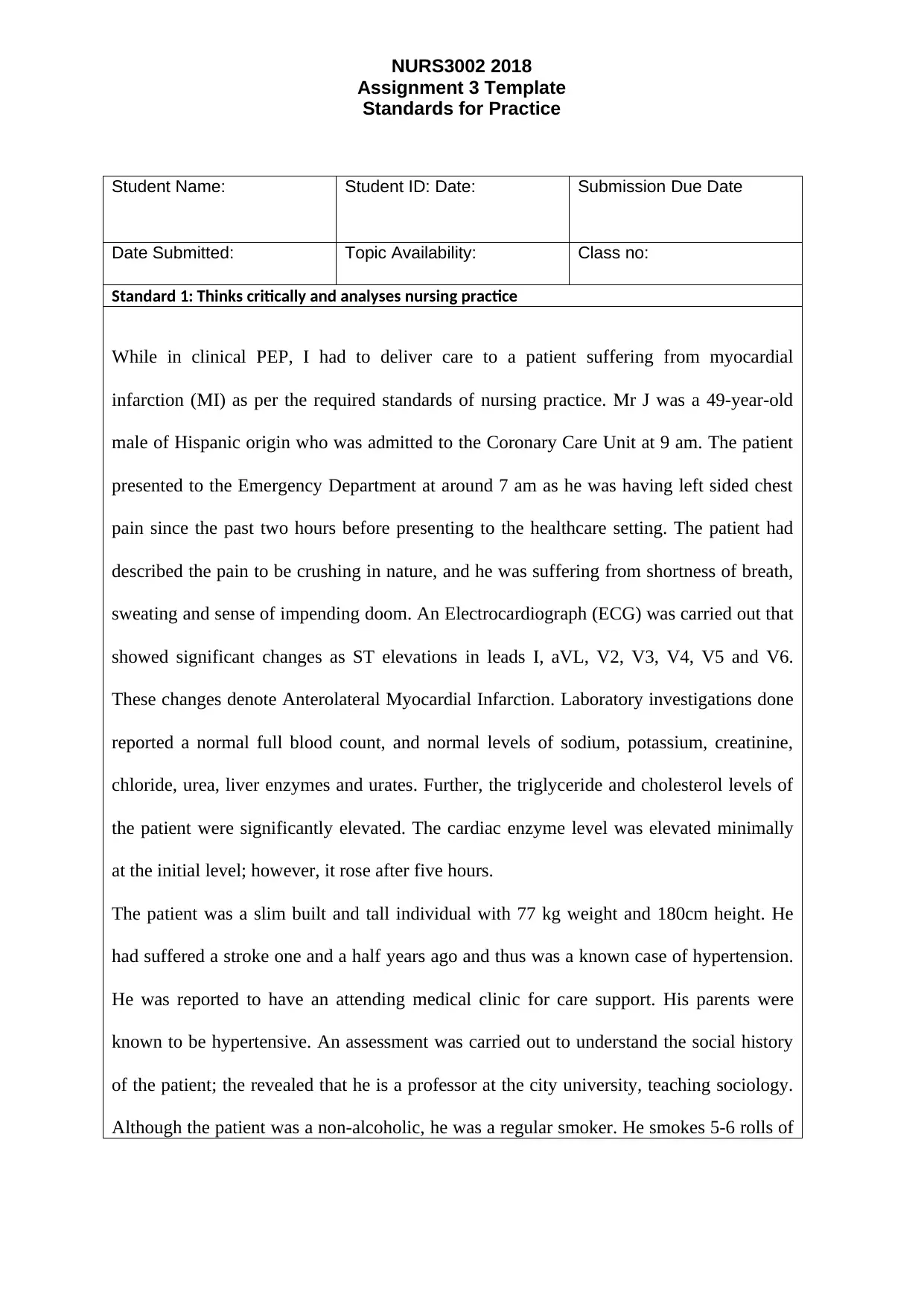
NURS3002 2018
Assignment 3 Template
Standards for Practice
Student Name: Student ID: Date: Submission Due Date
Date Submitted: Topic Availability: Class no:
Standard 1: Thinks critically and analyses nursing practice
While in clinical PEP, I had to deliver care to a patient suffering from myocardial
infarction (MI) as per the required standards of nursing practice. Mr J was a 49-year-old
male of Hispanic origin who was admitted to the Coronary Care Unit at 9 am. The patient
presented to the Emergency Department at around 7 am as he was having left sided chest
pain since the past two hours before presenting to the healthcare setting. The patient had
described the pain to be crushing in nature, and he was suffering from shortness of breath,
sweating and sense of impending doom. An Electrocardiograph (ECG) was carried out that
showed significant changes as ST elevations in leads I, aVL, V2, V3, V4, V5 and V6.
These changes denote Anterolateral Myocardial Infarction. Laboratory investigations done
reported a normal full blood count, and normal levels of sodium, potassium, creatinine,
chloride, urea, liver enzymes and urates. Further, the triglyceride and cholesterol levels of
the patient were significantly elevated. The cardiac enzyme level was elevated minimally
at the initial level; however, it rose after five hours.
The patient was a slim built and tall individual with 77 kg weight and 180cm height. He
had suffered a stroke one and a half years ago and thus was a known case of hypertension.
He was reported to have an attending medical clinic for care support. His parents were
known to be hypertensive. An assessment was carried out to understand the social history
of the patient; the revealed that he is a professor at the city university, teaching sociology.
Although the patient was a non-alcoholic, he was a regular smoker. He smokes 5-6 rolls of
Assignment 3 Template
Standards for Practice
Student Name: Student ID: Date: Submission Due Date
Date Submitted: Topic Availability: Class no:
Standard 1: Thinks critically and analyses nursing practice
While in clinical PEP, I had to deliver care to a patient suffering from myocardial
infarction (MI) as per the required standards of nursing practice. Mr J was a 49-year-old
male of Hispanic origin who was admitted to the Coronary Care Unit at 9 am. The patient
presented to the Emergency Department at around 7 am as he was having left sided chest
pain since the past two hours before presenting to the healthcare setting. The patient had
described the pain to be crushing in nature, and he was suffering from shortness of breath,
sweating and sense of impending doom. An Electrocardiograph (ECG) was carried out that
showed significant changes as ST elevations in leads I, aVL, V2, V3, V4, V5 and V6.
These changes denote Anterolateral Myocardial Infarction. Laboratory investigations done
reported a normal full blood count, and normal levels of sodium, potassium, creatinine,
chloride, urea, liver enzymes and urates. Further, the triglyceride and cholesterol levels of
the patient were significantly elevated. The cardiac enzyme level was elevated minimally
at the initial level; however, it rose after five hours.
The patient was a slim built and tall individual with 77 kg weight and 180cm height. He
had suffered a stroke one and a half years ago and thus was a known case of hypertension.
He was reported to have an attending medical clinic for care support. His parents were
known to be hypertensive. An assessment was carried out to understand the social history
of the patient; the revealed that he is a professor at the city university, teaching sociology.
Although the patient was a non-alcoholic, he was a regular smoker. He smokes 5-6 rolls of
Paraphrase This Document
Need a fresh take? Get an instant paraphrase of this document with our AI Paraphraser
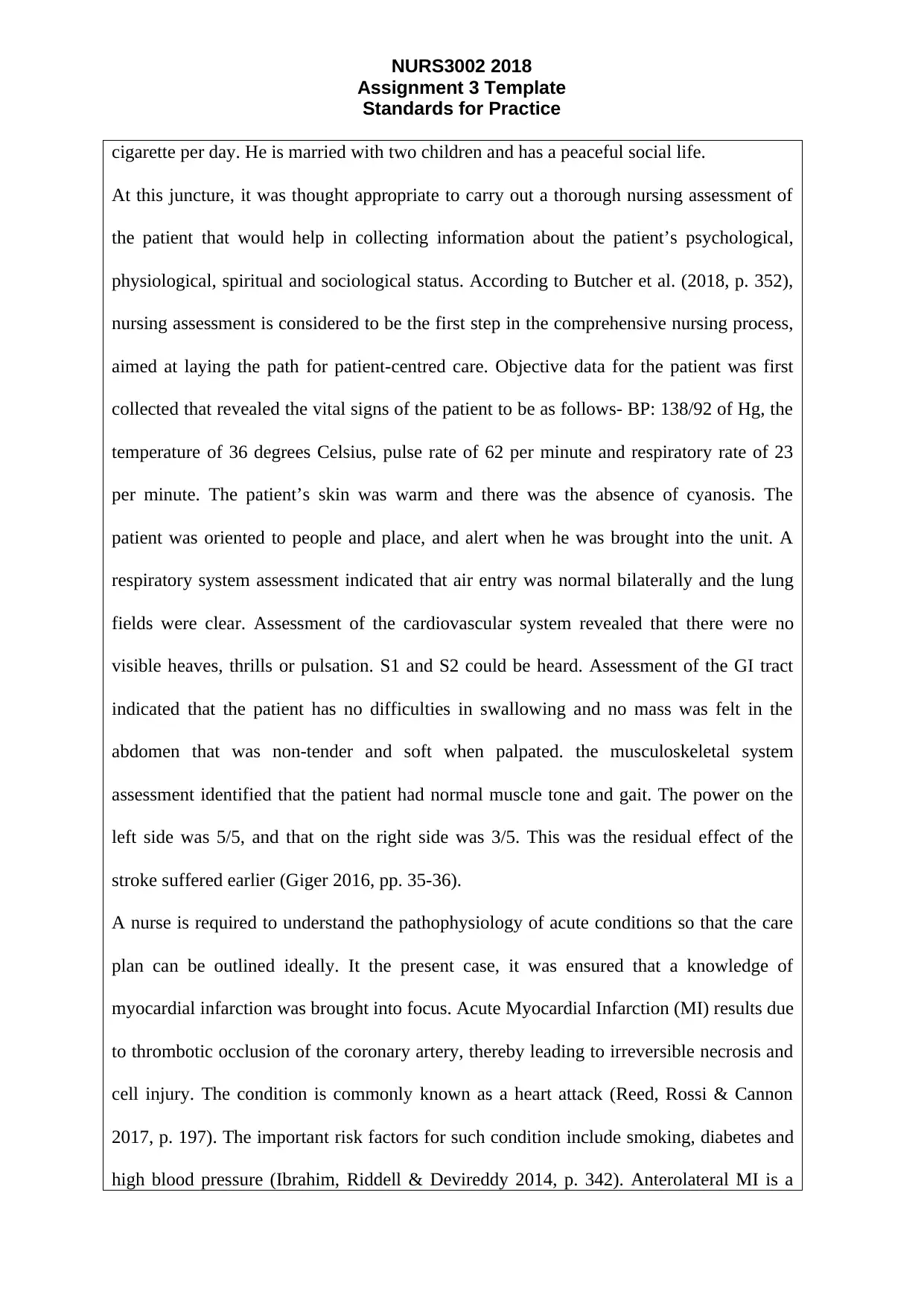
NURS3002 2018
Assignment 3 Template
Standards for Practice
cigarette per day. He is married with two children and has a peaceful social life.
At this juncture, it was thought appropriate to carry out a thorough nursing assessment of
the patient that would help in collecting information about the patient’s psychological,
physiological, spiritual and sociological status. According to Butcher et al. (2018, p. 352),
nursing assessment is considered to be the first step in the comprehensive nursing process,
aimed at laying the path for patient-centred care. Objective data for the patient was first
collected that revealed the vital signs of the patient to be as follows- BP: 138/92 of Hg, the
temperature of 36 degrees Celsius, pulse rate of 62 per minute and respiratory rate of 23
per minute. The patient’s skin was warm and there was the absence of cyanosis. The
patient was oriented to people and place, and alert when he was brought into the unit. A
respiratory system assessment indicated that air entry was normal bilaterally and the lung
fields were clear. Assessment of the cardiovascular system revealed that there were no
visible heaves, thrills or pulsation. S1 and S2 could be heard. Assessment of the GI tract
indicated that the patient has no difficulties in swallowing and no mass was felt in the
abdomen that was non-tender and soft when palpated. the musculoskeletal system
assessment identified that the patient had normal muscle tone and gait. The power on the
left side was 5/5, and that on the right side was 3/5. This was the residual effect of the
stroke suffered earlier (Giger 2016, pp. 35-36).
A nurse is required to understand the pathophysiology of acute conditions so that the care
plan can be outlined ideally. It the present case, it was ensured that a knowledge of
myocardial infarction was brought into focus. Acute Myocardial Infarction (MI) results due
to thrombotic occlusion of the coronary artery, thereby leading to irreversible necrosis and
cell injury. The condition is commonly known as a heart attack (Reed, Rossi & Cannon
2017, p. 197). The important risk factors for such condition include smoking, diabetes and
high blood pressure (Ibrahim, Riddell & Devireddy 2014, p. 342). Anterolateral MI is a
Assignment 3 Template
Standards for Practice
cigarette per day. He is married with two children and has a peaceful social life.
At this juncture, it was thought appropriate to carry out a thorough nursing assessment of
the patient that would help in collecting information about the patient’s psychological,
physiological, spiritual and sociological status. According to Butcher et al. (2018, p. 352),
nursing assessment is considered to be the first step in the comprehensive nursing process,
aimed at laying the path for patient-centred care. Objective data for the patient was first
collected that revealed the vital signs of the patient to be as follows- BP: 138/92 of Hg, the
temperature of 36 degrees Celsius, pulse rate of 62 per minute and respiratory rate of 23
per minute. The patient’s skin was warm and there was the absence of cyanosis. The
patient was oriented to people and place, and alert when he was brought into the unit. A
respiratory system assessment indicated that air entry was normal bilaterally and the lung
fields were clear. Assessment of the cardiovascular system revealed that there were no
visible heaves, thrills or pulsation. S1 and S2 could be heard. Assessment of the GI tract
indicated that the patient has no difficulties in swallowing and no mass was felt in the
abdomen that was non-tender and soft when palpated. the musculoskeletal system
assessment identified that the patient had normal muscle tone and gait. The power on the
left side was 5/5, and that on the right side was 3/5. This was the residual effect of the
stroke suffered earlier (Giger 2016, pp. 35-36).
A nurse is required to understand the pathophysiology of acute conditions so that the care
plan can be outlined ideally. It the present case, it was ensured that a knowledge of
myocardial infarction was brought into focus. Acute Myocardial Infarction (MI) results due
to thrombotic occlusion of the coronary artery, thereby leading to irreversible necrosis and
cell injury. The condition is commonly known as a heart attack (Reed, Rossi & Cannon
2017, p. 197). The important risk factors for such condition include smoking, diabetes and
high blood pressure (Ibrahim, Riddell & Devireddy 2014, p. 342). Anterolateral MI is a
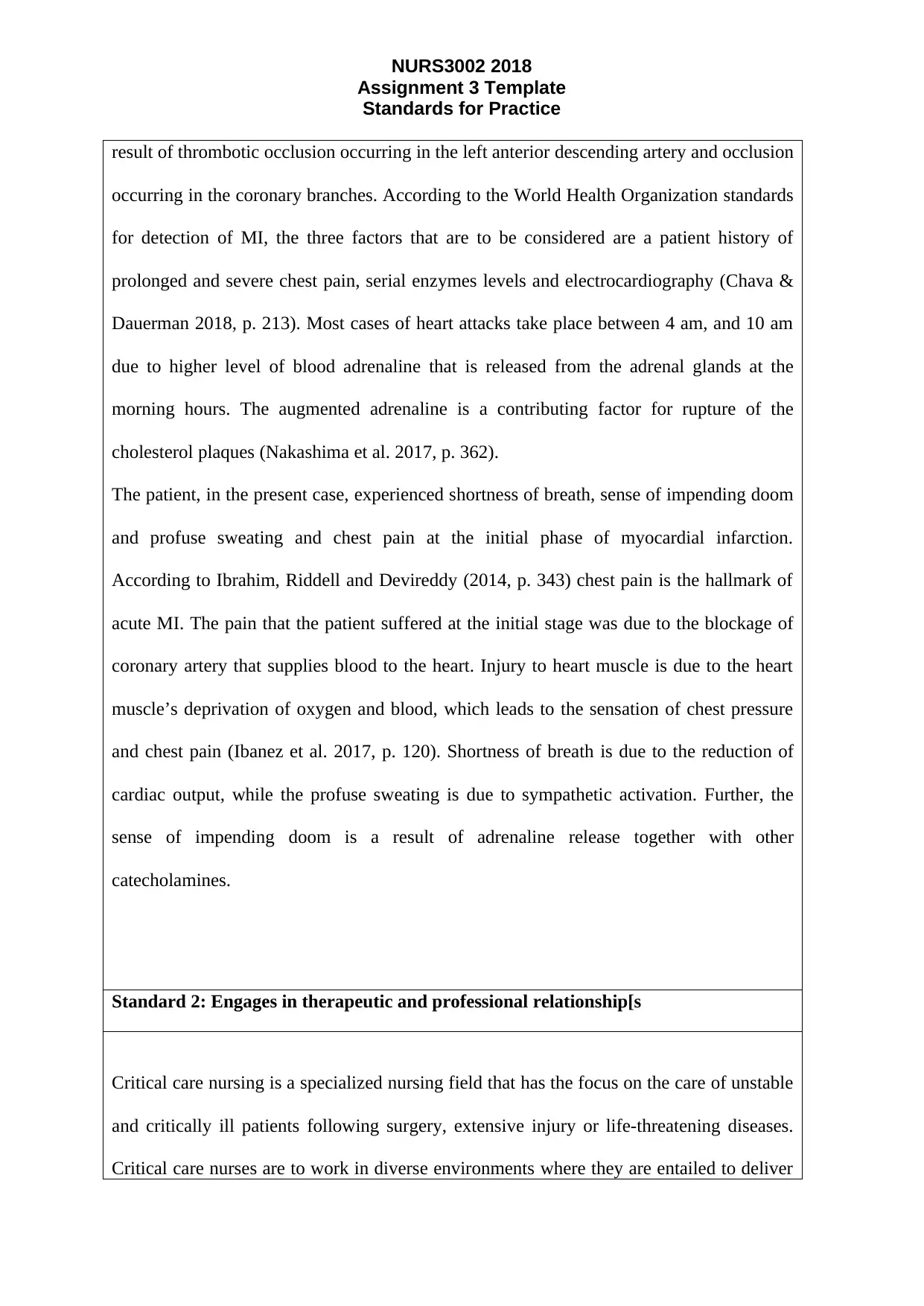
NURS3002 2018
Assignment 3 Template
Standards for Practice
result of thrombotic occlusion occurring in the left anterior descending artery and occlusion
occurring in the coronary branches. According to the World Health Organization standards
for detection of MI, the three factors that are to be considered are a patient history of
prolonged and severe chest pain, serial enzymes levels and electrocardiography (Chava &
Dauerman 2018, p. 213). Most cases of heart attacks take place between 4 am, and 10 am
due to higher level of blood adrenaline that is released from the adrenal glands at the
morning hours. The augmented adrenaline is a contributing factor for rupture of the
cholesterol plaques (Nakashima et al. 2017, p. 362).
The patient, in the present case, experienced shortness of breath, sense of impending doom
and profuse sweating and chest pain at the initial phase of myocardial infarction.
According to Ibrahim, Riddell and Devireddy (2014, p. 343) chest pain is the hallmark of
acute MI. The pain that the patient suffered at the initial stage was due to the blockage of
coronary artery that supplies blood to the heart. Injury to heart muscle is due to the heart
muscle’s deprivation of oxygen and blood, which leads to the sensation of chest pressure
and chest pain (Ibanez et al. 2017, p. 120). Shortness of breath is due to the reduction of
cardiac output, while the profuse sweating is due to sympathetic activation. Further, the
sense of impending doom is a result of adrenaline release together with other
catecholamines.
Standard 2: Engages in therapeutic and professional relationship[s
Critical care nursing is a specialized nursing field that has the focus on the care of unstable
and critically ill patients following surgery, extensive injury or life-threatening diseases.
Critical care nurses are to work in diverse environments where they are entailed to deliver
Assignment 3 Template
Standards for Practice
result of thrombotic occlusion occurring in the left anterior descending artery and occlusion
occurring in the coronary branches. According to the World Health Organization standards
for detection of MI, the three factors that are to be considered are a patient history of
prolonged and severe chest pain, serial enzymes levels and electrocardiography (Chava &
Dauerman 2018, p. 213). Most cases of heart attacks take place between 4 am, and 10 am
due to higher level of blood adrenaline that is released from the adrenal glands at the
morning hours. The augmented adrenaline is a contributing factor for rupture of the
cholesterol plaques (Nakashima et al. 2017, p. 362).
The patient, in the present case, experienced shortness of breath, sense of impending doom
and profuse sweating and chest pain at the initial phase of myocardial infarction.
According to Ibrahim, Riddell and Devireddy (2014, p. 343) chest pain is the hallmark of
acute MI. The pain that the patient suffered at the initial stage was due to the blockage of
coronary artery that supplies blood to the heart. Injury to heart muscle is due to the heart
muscle’s deprivation of oxygen and blood, which leads to the sensation of chest pressure
and chest pain (Ibanez et al. 2017, p. 120). Shortness of breath is due to the reduction of
cardiac output, while the profuse sweating is due to sympathetic activation. Further, the
sense of impending doom is a result of adrenaline release together with other
catecholamines.
Standard 2: Engages in therapeutic and professional relationship[s
Critical care nursing is a specialized nursing field that has the focus on the care of unstable
and critically ill patients following surgery, extensive injury or life-threatening diseases.
Critical care nurses are to work in diverse environments where they are entailed to deliver
⊘ This is a preview!⊘
Do you want full access?
Subscribe today to unlock all pages.

Trusted by 1+ million students worldwide
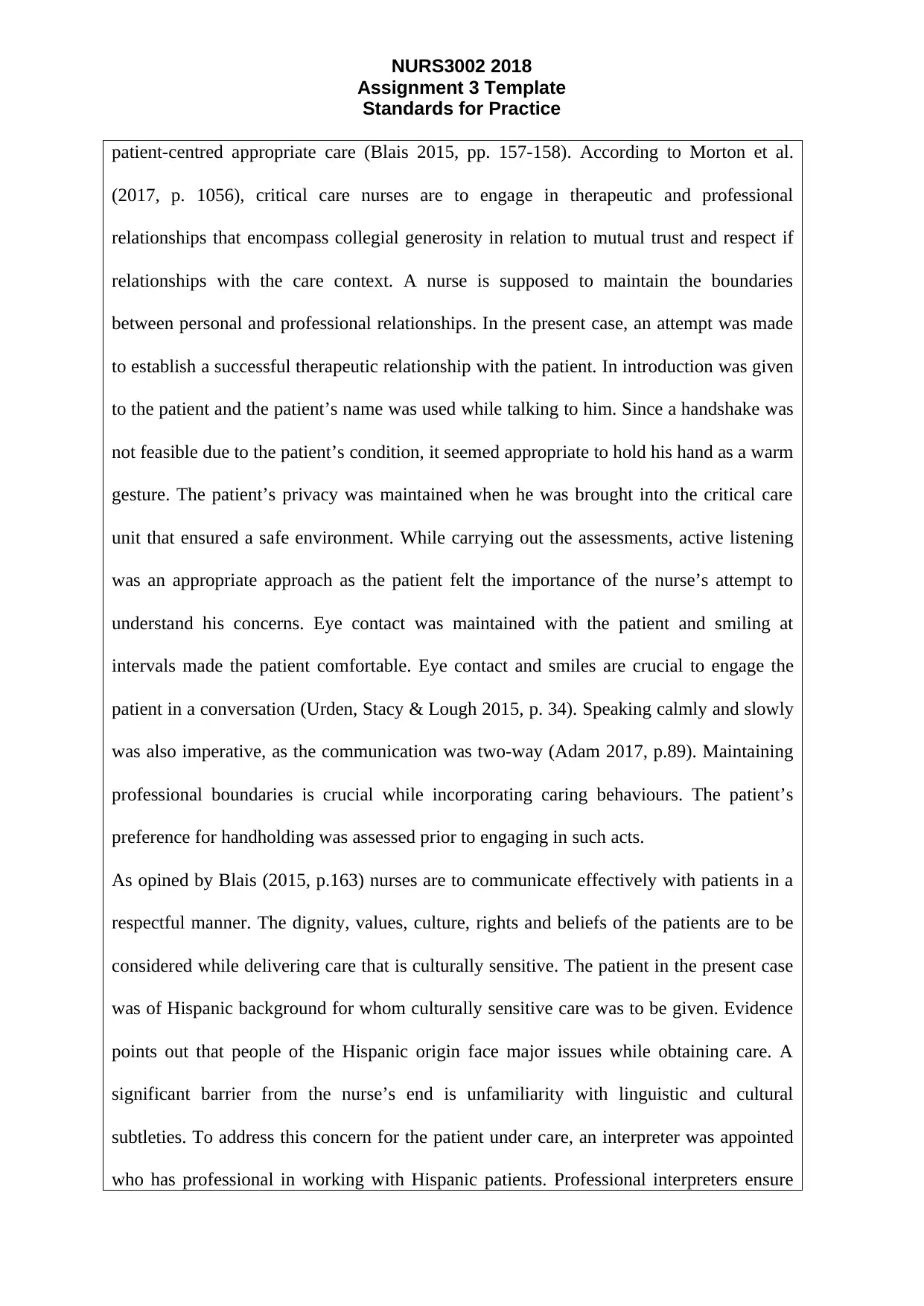
NURS3002 2018
Assignment 3 Template
Standards for Practice
patient-centred appropriate care (Blais 2015, pp. 157-158). According to Morton et al.
(2017, p. 1056), critical care nurses are to engage in therapeutic and professional
relationships that encompass collegial generosity in relation to mutual trust and respect if
relationships with the care context. A nurse is supposed to maintain the boundaries
between personal and professional relationships. In the present case, an attempt was made
to establish a successful therapeutic relationship with the patient. In introduction was given
to the patient and the patient’s name was used while talking to him. Since a handshake was
not feasible due to the patient’s condition, it seemed appropriate to hold his hand as a warm
gesture. The patient’s privacy was maintained when he was brought into the critical care
unit that ensured a safe environment. While carrying out the assessments, active listening
was an appropriate approach as the patient felt the importance of the nurse’s attempt to
understand his concerns. Eye contact was maintained with the patient and smiling at
intervals made the patient comfortable. Eye contact and smiles are crucial to engage the
patient in a conversation (Urden, Stacy & Lough 2015, p. 34). Speaking calmly and slowly
was also imperative, as the communication was two-way (Adam 2017, p.89). Maintaining
professional boundaries is crucial while incorporating caring behaviours. The patient’s
preference for handholding was assessed prior to engaging in such acts.
As opined by Blais (2015, p.163) nurses are to communicate effectively with patients in a
respectful manner. The dignity, values, culture, rights and beliefs of the patients are to be
considered while delivering care that is culturally sensitive. The patient in the present case
was of Hispanic background for whom culturally sensitive care was to be given. Evidence
points out that people of the Hispanic origin face major issues while obtaining care. A
significant barrier from the nurse’s end is unfamiliarity with linguistic and cultural
subtleties. To address this concern for the patient under care, an interpreter was appointed
who has professional in working with Hispanic patients. Professional interpreters ensure
Assignment 3 Template
Standards for Practice
patient-centred appropriate care (Blais 2015, pp. 157-158). According to Morton et al.
(2017, p. 1056), critical care nurses are to engage in therapeutic and professional
relationships that encompass collegial generosity in relation to mutual trust and respect if
relationships with the care context. A nurse is supposed to maintain the boundaries
between personal and professional relationships. In the present case, an attempt was made
to establish a successful therapeutic relationship with the patient. In introduction was given
to the patient and the patient’s name was used while talking to him. Since a handshake was
not feasible due to the patient’s condition, it seemed appropriate to hold his hand as a warm
gesture. The patient’s privacy was maintained when he was brought into the critical care
unit that ensured a safe environment. While carrying out the assessments, active listening
was an appropriate approach as the patient felt the importance of the nurse’s attempt to
understand his concerns. Eye contact was maintained with the patient and smiling at
intervals made the patient comfortable. Eye contact and smiles are crucial to engage the
patient in a conversation (Urden, Stacy & Lough 2015, p. 34). Speaking calmly and slowly
was also imperative, as the communication was two-way (Adam 2017, p.89). Maintaining
professional boundaries is crucial while incorporating caring behaviours. The patient’s
preference for handholding was assessed prior to engaging in such acts.
As opined by Blais (2015, p.163) nurses are to communicate effectively with patients in a
respectful manner. The dignity, values, culture, rights and beliefs of the patients are to be
considered while delivering care that is culturally sensitive. The patient in the present case
was of Hispanic background for whom culturally sensitive care was to be given. Evidence
points out that people of the Hispanic origin face major issues while obtaining care. A
significant barrier from the nurse’s end is unfamiliarity with linguistic and cultural
subtleties. To address this concern for the patient under care, an interpreter was appointed
who has professional in working with Hispanic patients. Professional interpreters ensure
Paraphrase This Document
Need a fresh take? Get an instant paraphrase of this document with our AI Paraphraser
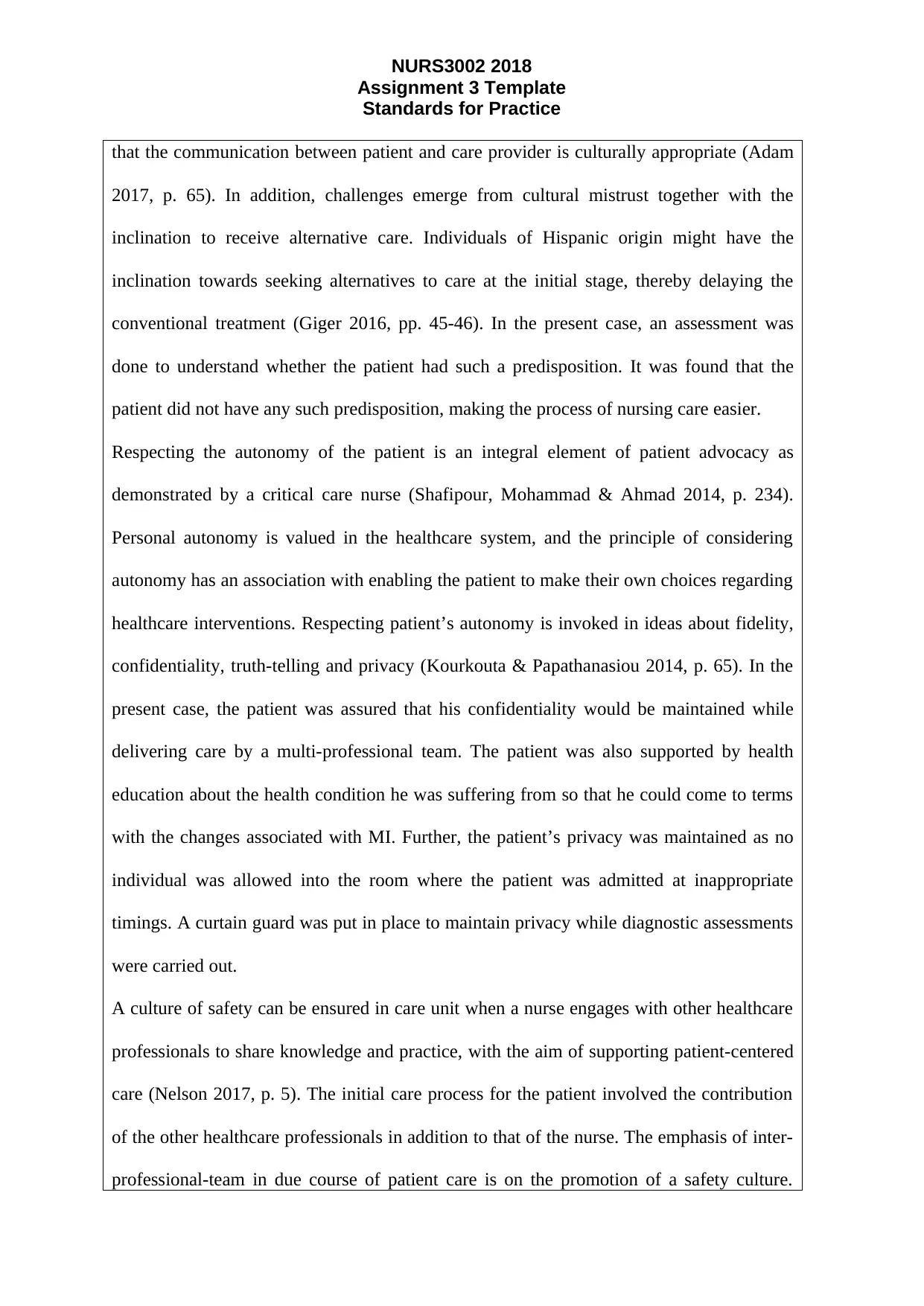
NURS3002 2018
Assignment 3 Template
Standards for Practice
that the communication between patient and care provider is culturally appropriate (Adam
2017, p. 65). In addition, challenges emerge from cultural mistrust together with the
inclination to receive alternative care. Individuals of Hispanic origin might have the
inclination towards seeking alternatives to care at the initial stage, thereby delaying the
conventional treatment (Giger 2016, pp. 45-46). In the present case, an assessment was
done to understand whether the patient had such a predisposition. It was found that the
patient did not have any such predisposition, making the process of nursing care easier.
Respecting the autonomy of the patient is an integral element of patient advocacy as
demonstrated by a critical care nurse (Shafipour, Mohammad & Ahmad 2014, p. 234).
Personal autonomy is valued in the healthcare system, and the principle of considering
autonomy has an association with enabling the patient to make their own choices regarding
healthcare interventions. Respecting patient’s autonomy is invoked in ideas about fidelity,
confidentiality, truth-telling and privacy (Kourkouta & Papathanasiou 2014, p. 65). In the
present case, the patient was assured that his confidentiality would be maintained while
delivering care by a multi-professional team. The patient was also supported by health
education about the health condition he was suffering from so that he could come to terms
with the changes associated with MI. Further, the patient’s privacy was maintained as no
individual was allowed into the room where the patient was admitted at inappropriate
timings. A curtain guard was put in place to maintain privacy while diagnostic assessments
were carried out.
A culture of safety can be ensured in care unit when a nurse engages with other healthcare
professionals to share knowledge and practice, with the aim of supporting patient-centered
care (Nelson 2017, p. 5). The initial care process for the patient involved the contribution
of the other healthcare professionals in addition to that of the nurse. The emphasis of inter-
professional-team in due course of patient care is on the promotion of a safety culture.
Assignment 3 Template
Standards for Practice
that the communication between patient and care provider is culturally appropriate (Adam
2017, p. 65). In addition, challenges emerge from cultural mistrust together with the
inclination to receive alternative care. Individuals of Hispanic origin might have the
inclination towards seeking alternatives to care at the initial stage, thereby delaying the
conventional treatment (Giger 2016, pp. 45-46). In the present case, an assessment was
done to understand whether the patient had such a predisposition. It was found that the
patient did not have any such predisposition, making the process of nursing care easier.
Respecting the autonomy of the patient is an integral element of patient advocacy as
demonstrated by a critical care nurse (Shafipour, Mohammad & Ahmad 2014, p. 234).
Personal autonomy is valued in the healthcare system, and the principle of considering
autonomy has an association with enabling the patient to make their own choices regarding
healthcare interventions. Respecting patient’s autonomy is invoked in ideas about fidelity,
confidentiality, truth-telling and privacy (Kourkouta & Papathanasiou 2014, p. 65). In the
present case, the patient was assured that his confidentiality would be maintained while
delivering care by a multi-professional team. The patient was also supported by health
education about the health condition he was suffering from so that he could come to terms
with the changes associated with MI. Further, the patient’s privacy was maintained as no
individual was allowed into the room where the patient was admitted at inappropriate
timings. A curtain guard was put in place to maintain privacy while diagnostic assessments
were carried out.
A culture of safety can be ensured in care unit when a nurse engages with other healthcare
professionals to share knowledge and practice, with the aim of supporting patient-centered
care (Nelson 2017, p. 5). The initial care process for the patient involved the contribution
of the other healthcare professionals in addition to that of the nurse. The emphasis of inter-
professional-team in due course of patient care is on the promotion of a safety culture.
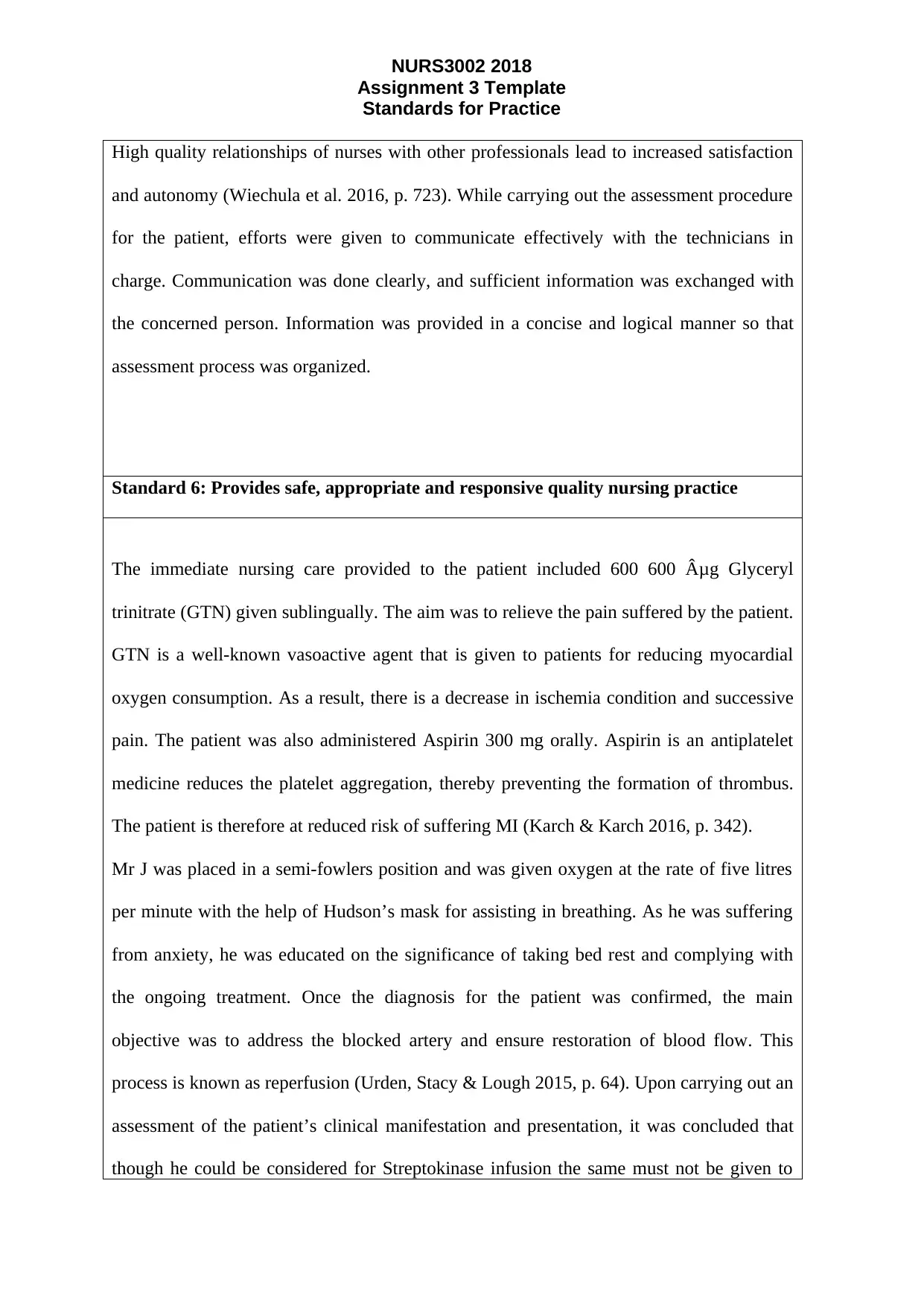
NURS3002 2018
Assignment 3 Template
Standards for Practice
High quality relationships of nurses with other professionals lead to increased satisfaction
and autonomy (Wiechula et al. 2016, p. 723). While carrying out the assessment procedure
for the patient, efforts were given to communicate effectively with the technicians in
charge. Communication was done clearly, and sufficient information was exchanged with
the concerned person. Information was provided in a concise and logical manner so that
assessment process was organized.
Standard 6: Provides safe, appropriate and responsive quality nursing practice
The immediate nursing care provided to the patient included 600 600 Âμg Glyceryl
trinitrate (GTN) given sublingually. The aim was to relieve the pain suffered by the patient.
GTN is a well-known vasoactive agent that is given to patients for reducing myocardial
oxygen consumption. As a result, there is a decrease in ischemia condition and successive
pain. The patient was also administered Aspirin 300 mg orally. Aspirin is an antiplatelet
medicine reduces the platelet aggregation, thereby preventing the formation of thrombus.
The patient is therefore at reduced risk of suffering MI (Karch & Karch 2016, p. 342).
Mr J was placed in a semi-fowlers position and was given oxygen at the rate of five litres
per minute with the help of Hudson’s mask for assisting in breathing. As he was suffering
from anxiety, he was educated on the significance of taking bed rest and complying with
the ongoing treatment. Once the diagnosis for the patient was confirmed, the main
objective was to address the blocked artery and ensure restoration of blood flow. This
process is known as reperfusion (Urden, Stacy & Lough 2015, p. 64). Upon carrying out an
assessment of the patient’s clinical manifestation and presentation, it was concluded that
though he could be considered for Streptokinase infusion the same must not be given to
Assignment 3 Template
Standards for Practice
High quality relationships of nurses with other professionals lead to increased satisfaction
and autonomy (Wiechula et al. 2016, p. 723). While carrying out the assessment procedure
for the patient, efforts were given to communicate effectively with the technicians in
charge. Communication was done clearly, and sufficient information was exchanged with
the concerned person. Information was provided in a concise and logical manner so that
assessment process was organized.
Standard 6: Provides safe, appropriate and responsive quality nursing practice
The immediate nursing care provided to the patient included 600 600 Âμg Glyceryl
trinitrate (GTN) given sublingually. The aim was to relieve the pain suffered by the patient.
GTN is a well-known vasoactive agent that is given to patients for reducing myocardial
oxygen consumption. As a result, there is a decrease in ischemia condition and successive
pain. The patient was also administered Aspirin 300 mg orally. Aspirin is an antiplatelet
medicine reduces the platelet aggregation, thereby preventing the formation of thrombus.
The patient is therefore at reduced risk of suffering MI (Karch & Karch 2016, p. 342).
Mr J was placed in a semi-fowlers position and was given oxygen at the rate of five litres
per minute with the help of Hudson’s mask for assisting in breathing. As he was suffering
from anxiety, he was educated on the significance of taking bed rest and complying with
the ongoing treatment. Once the diagnosis for the patient was confirmed, the main
objective was to address the blocked artery and ensure restoration of blood flow. This
process is known as reperfusion (Urden, Stacy & Lough 2015, p. 64). Upon carrying out an
assessment of the patient’s clinical manifestation and presentation, it was concluded that
though he could be considered for Streptokinase infusion the same must not be given to
⊘ This is a preview!⊘
Do you want full access?
Subscribe today to unlock all pages.

Trusted by 1+ million students worldwide
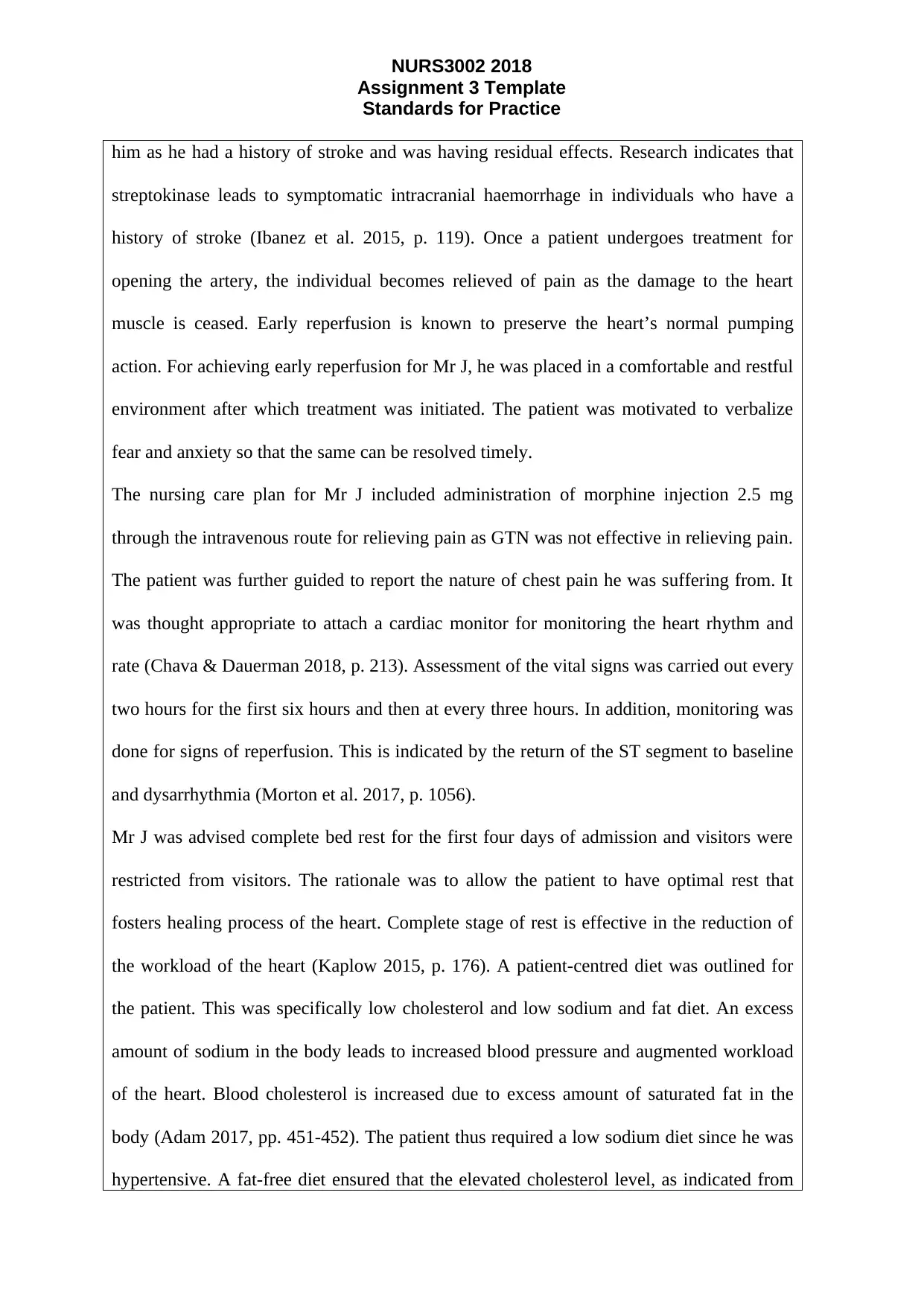
NURS3002 2018
Assignment 3 Template
Standards for Practice
him as he had a history of stroke and was having residual effects. Research indicates that
streptokinase leads to symptomatic intracranial haemorrhage in individuals who have a
history of stroke (Ibanez et al. 2015, p. 119). Once a patient undergoes treatment for
opening the artery, the individual becomes relieved of pain as the damage to the heart
muscle is ceased. Early reperfusion is known to preserve the heart’s normal pumping
action. For achieving early reperfusion for Mr J, he was placed in a comfortable and restful
environment after which treatment was initiated. The patient was motivated to verbalize
fear and anxiety so that the same can be resolved timely.
The nursing care plan for Mr J included administration of morphine injection 2.5 mg
through the intravenous route for relieving pain as GTN was not effective in relieving pain.
The patient was further guided to report the nature of chest pain he was suffering from. It
was thought appropriate to attach a cardiac monitor for monitoring the heart rhythm and
rate (Chava & Dauerman 2018, p. 213). Assessment of the vital signs was carried out every
two hours for the first six hours and then at every three hours. In addition, monitoring was
done for signs of reperfusion. This is indicated by the return of the ST segment to baseline
and dysarrhythmia (Morton et al. 2017, p. 1056).
Mr J was advised complete bed rest for the first four days of admission and visitors were
restricted from visitors. The rationale was to allow the patient to have optimal rest that
fosters healing process of the heart. Complete stage of rest is effective in the reduction of
the workload of the heart (Kaplow 2015, p. 176). A patient-centred diet was outlined for
the patient. This was specifically low cholesterol and low sodium and fat diet. An excess
amount of sodium in the body leads to increased blood pressure and augmented workload
of the heart. Blood cholesterol is increased due to excess amount of saturated fat in the
body (Adam 2017, pp. 451-452). The patient thus required a low sodium diet since he was
hypertensive. A fat-free diet ensured that the elevated cholesterol level, as indicated from
Assignment 3 Template
Standards for Practice
him as he had a history of stroke and was having residual effects. Research indicates that
streptokinase leads to symptomatic intracranial haemorrhage in individuals who have a
history of stroke (Ibanez et al. 2015, p. 119). Once a patient undergoes treatment for
opening the artery, the individual becomes relieved of pain as the damage to the heart
muscle is ceased. Early reperfusion is known to preserve the heart’s normal pumping
action. For achieving early reperfusion for Mr J, he was placed in a comfortable and restful
environment after which treatment was initiated. The patient was motivated to verbalize
fear and anxiety so that the same can be resolved timely.
The nursing care plan for Mr J included administration of morphine injection 2.5 mg
through the intravenous route for relieving pain as GTN was not effective in relieving pain.
The patient was further guided to report the nature of chest pain he was suffering from. It
was thought appropriate to attach a cardiac monitor for monitoring the heart rhythm and
rate (Chava & Dauerman 2018, p. 213). Assessment of the vital signs was carried out every
two hours for the first six hours and then at every three hours. In addition, monitoring was
done for signs of reperfusion. This is indicated by the return of the ST segment to baseline
and dysarrhythmia (Morton et al. 2017, p. 1056).
Mr J was advised complete bed rest for the first four days of admission and visitors were
restricted from visitors. The rationale was to allow the patient to have optimal rest that
fosters healing process of the heart. Complete stage of rest is effective in the reduction of
the workload of the heart (Kaplow 2015, p. 176). A patient-centred diet was outlined for
the patient. This was specifically low cholesterol and low sodium and fat diet. An excess
amount of sodium in the body leads to increased blood pressure and augmented workload
of the heart. Blood cholesterol is increased due to excess amount of saturated fat in the
body (Adam 2017, pp. 451-452). The patient thus required a low sodium diet since he was
hypertensive. A fat-free diet ensured that the elevated cholesterol level, as indicated from
Paraphrase This Document
Need a fresh take? Get an instant paraphrase of this document with our AI Paraphraser
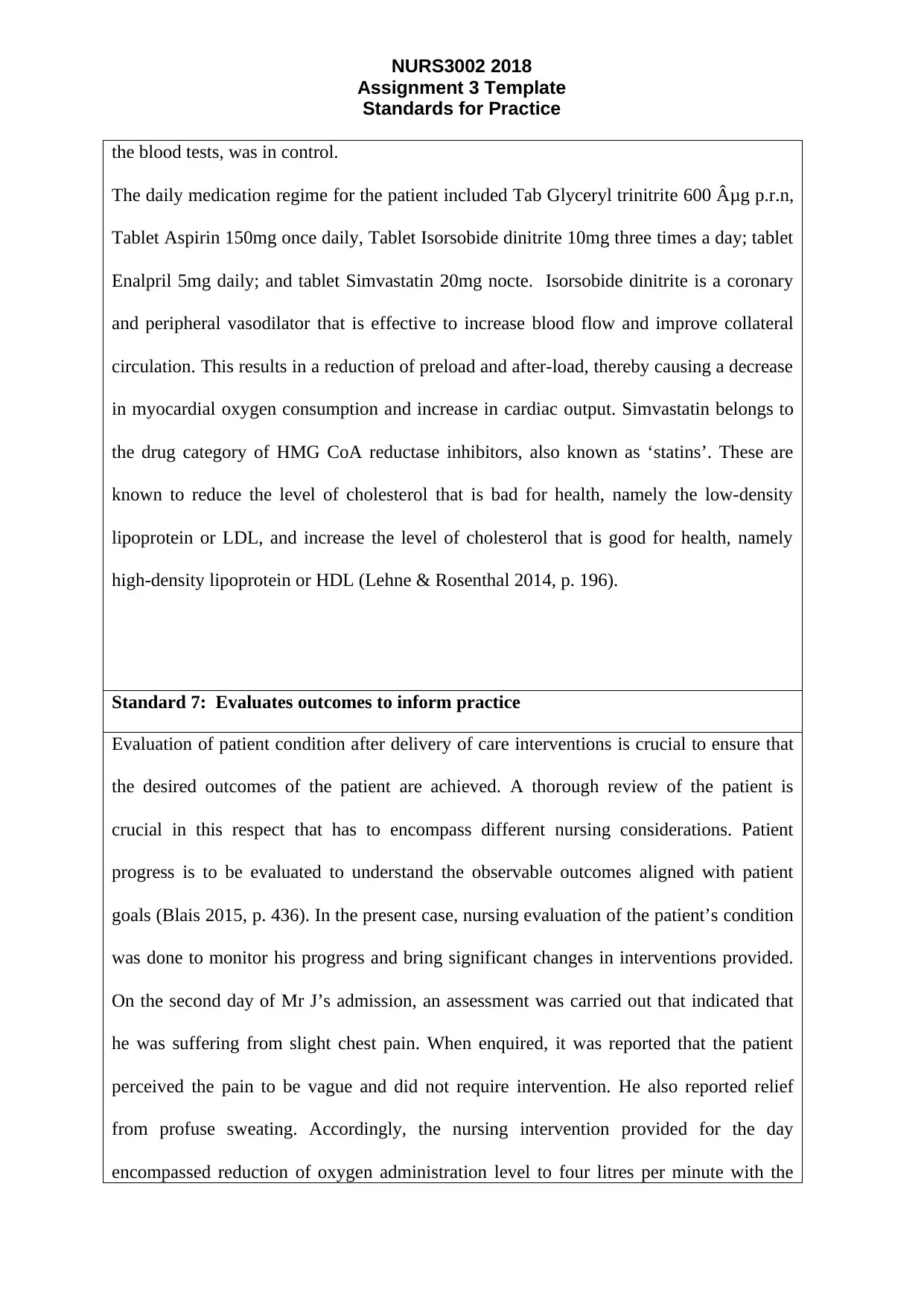
NURS3002 2018
Assignment 3 Template
Standards for Practice
the blood tests, was in control.
The daily medication regime for the patient included Tab Glyceryl trinitrite 600 Âμg p.r.n,
Tablet Aspirin 150mg once daily, Tablet Isorsobide dinitrite 10mg three times a day; tablet
Enalpril 5mg daily; and tablet Simvastatin 20mg nocte. Isorsobide dinitrite is a coronary
and peripheral vasodilator that is effective to increase blood flow and improve collateral
circulation. This results in a reduction of preload and after-load, thereby causing a decrease
in myocardial oxygen consumption and increase in cardiac output. Simvastatin belongs to
the drug category of HMG CoA reductase inhibitors, also known as ‘statins’. These are
known to reduce the level of cholesterol that is bad for health, namely the low-density
lipoprotein or LDL, and increase the level of cholesterol that is good for health, namely
high-density lipoprotein or HDL (Lehne & Rosenthal 2014, p. 196).
Standard 7: Evaluates outcomes to inform practice
Evaluation of patient condition after delivery of care interventions is crucial to ensure that
the desired outcomes of the patient are achieved. A thorough review of the patient is
crucial in this respect that has to encompass different nursing considerations. Patient
progress is to be evaluated to understand the observable outcomes aligned with patient
goals (Blais 2015, p. 436). In the present case, nursing evaluation of the patient’s condition
was done to monitor his progress and bring significant changes in interventions provided.
On the second day of Mr J’s admission, an assessment was carried out that indicated that
he was suffering from slight chest pain. When enquired, it was reported that the patient
perceived the pain to be vague and did not require intervention. He also reported relief
from profuse sweating. Accordingly, the nursing intervention provided for the day
encompassed reduction of oxygen administration level to four litres per minute with the
Assignment 3 Template
Standards for Practice
the blood tests, was in control.
The daily medication regime for the patient included Tab Glyceryl trinitrite 600 Âμg p.r.n,
Tablet Aspirin 150mg once daily, Tablet Isorsobide dinitrite 10mg three times a day; tablet
Enalpril 5mg daily; and tablet Simvastatin 20mg nocte. Isorsobide dinitrite is a coronary
and peripheral vasodilator that is effective to increase blood flow and improve collateral
circulation. This results in a reduction of preload and after-load, thereby causing a decrease
in myocardial oxygen consumption and increase in cardiac output. Simvastatin belongs to
the drug category of HMG CoA reductase inhibitors, also known as ‘statins’. These are
known to reduce the level of cholesterol that is bad for health, namely the low-density
lipoprotein or LDL, and increase the level of cholesterol that is good for health, namely
high-density lipoprotein or HDL (Lehne & Rosenthal 2014, p. 196).
Standard 7: Evaluates outcomes to inform practice
Evaluation of patient condition after delivery of care interventions is crucial to ensure that
the desired outcomes of the patient are achieved. A thorough review of the patient is
crucial in this respect that has to encompass different nursing considerations. Patient
progress is to be evaluated to understand the observable outcomes aligned with patient
goals (Blais 2015, p. 436). In the present case, nursing evaluation of the patient’s condition
was done to monitor his progress and bring significant changes in interventions provided.
On the second day of Mr J’s admission, an assessment was carried out that indicated that
he was suffering from slight chest pain. When enquired, it was reported that the patient
perceived the pain to be vague and did not require intervention. He also reported relief
from profuse sweating. Accordingly, the nursing intervention provided for the day
encompassed reduction of oxygen administration level to four litres per minute with the
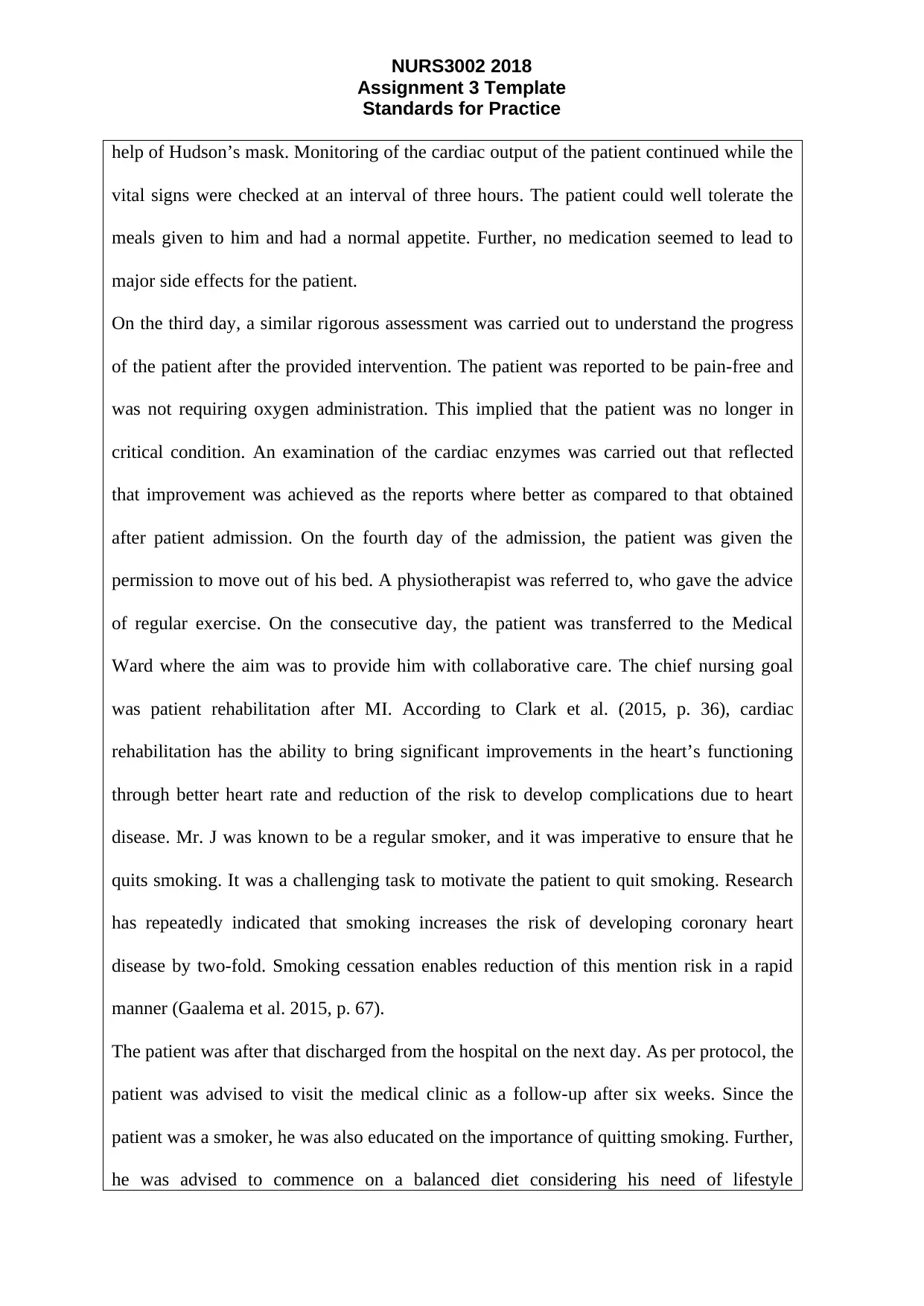
NURS3002 2018
Assignment 3 Template
Standards for Practice
help of Hudson’s mask. Monitoring of the cardiac output of the patient continued while the
vital signs were checked at an interval of three hours. The patient could well tolerate the
meals given to him and had a normal appetite. Further, no medication seemed to lead to
major side effects for the patient.
On the third day, a similar rigorous assessment was carried out to understand the progress
of the patient after the provided intervention. The patient was reported to be pain-free and
was not requiring oxygen administration. This implied that the patient was no longer in
critical condition. An examination of the cardiac enzymes was carried out that reflected
that improvement was achieved as the reports where better as compared to that obtained
after patient admission. On the fourth day of the admission, the patient was given the
permission to move out of his bed. A physiotherapist was referred to, who gave the advice
of regular exercise. On the consecutive day, the patient was transferred to the Medical
Ward where the aim was to provide him with collaborative care. The chief nursing goal
was patient rehabilitation after MI. According to Clark et al. (2015, p. 36), cardiac
rehabilitation has the ability to bring significant improvements in the heart’s functioning
through better heart rate and reduction of the risk to develop complications due to heart
disease. Mr. J was known to be a regular smoker, and it was imperative to ensure that he
quits smoking. It was a challenging task to motivate the patient to quit smoking. Research
has repeatedly indicated that smoking increases the risk of developing coronary heart
disease by two-fold. Smoking cessation enables reduction of this mention risk in a rapid
manner (Gaalema et al. 2015, p. 67).
The patient was after that discharged from the hospital on the next day. As per protocol, the
patient was advised to visit the medical clinic as a follow-up after six weeks. Since the
patient was a smoker, he was also educated on the importance of quitting smoking. Further,
he was advised to commence on a balanced diet considering his need of lifestyle
Assignment 3 Template
Standards for Practice
help of Hudson’s mask. Monitoring of the cardiac output of the patient continued while the
vital signs were checked at an interval of three hours. The patient could well tolerate the
meals given to him and had a normal appetite. Further, no medication seemed to lead to
major side effects for the patient.
On the third day, a similar rigorous assessment was carried out to understand the progress
of the patient after the provided intervention. The patient was reported to be pain-free and
was not requiring oxygen administration. This implied that the patient was no longer in
critical condition. An examination of the cardiac enzymes was carried out that reflected
that improvement was achieved as the reports where better as compared to that obtained
after patient admission. On the fourth day of the admission, the patient was given the
permission to move out of his bed. A physiotherapist was referred to, who gave the advice
of regular exercise. On the consecutive day, the patient was transferred to the Medical
Ward where the aim was to provide him with collaborative care. The chief nursing goal
was patient rehabilitation after MI. According to Clark et al. (2015, p. 36), cardiac
rehabilitation has the ability to bring significant improvements in the heart’s functioning
through better heart rate and reduction of the risk to develop complications due to heart
disease. Mr. J was known to be a regular smoker, and it was imperative to ensure that he
quits smoking. It was a challenging task to motivate the patient to quit smoking. Research
has repeatedly indicated that smoking increases the risk of developing coronary heart
disease by two-fold. Smoking cessation enables reduction of this mention risk in a rapid
manner (Gaalema et al. 2015, p. 67).
The patient was after that discharged from the hospital on the next day. As per protocol, the
patient was advised to visit the medical clinic as a follow-up after six weeks. Since the
patient was a smoker, he was also educated on the importance of quitting smoking. Further,
he was advised to commence on a balanced diet considering his need of lifestyle
⊘ This is a preview!⊘
Do you want full access?
Subscribe today to unlock all pages.

Trusted by 1+ million students worldwide
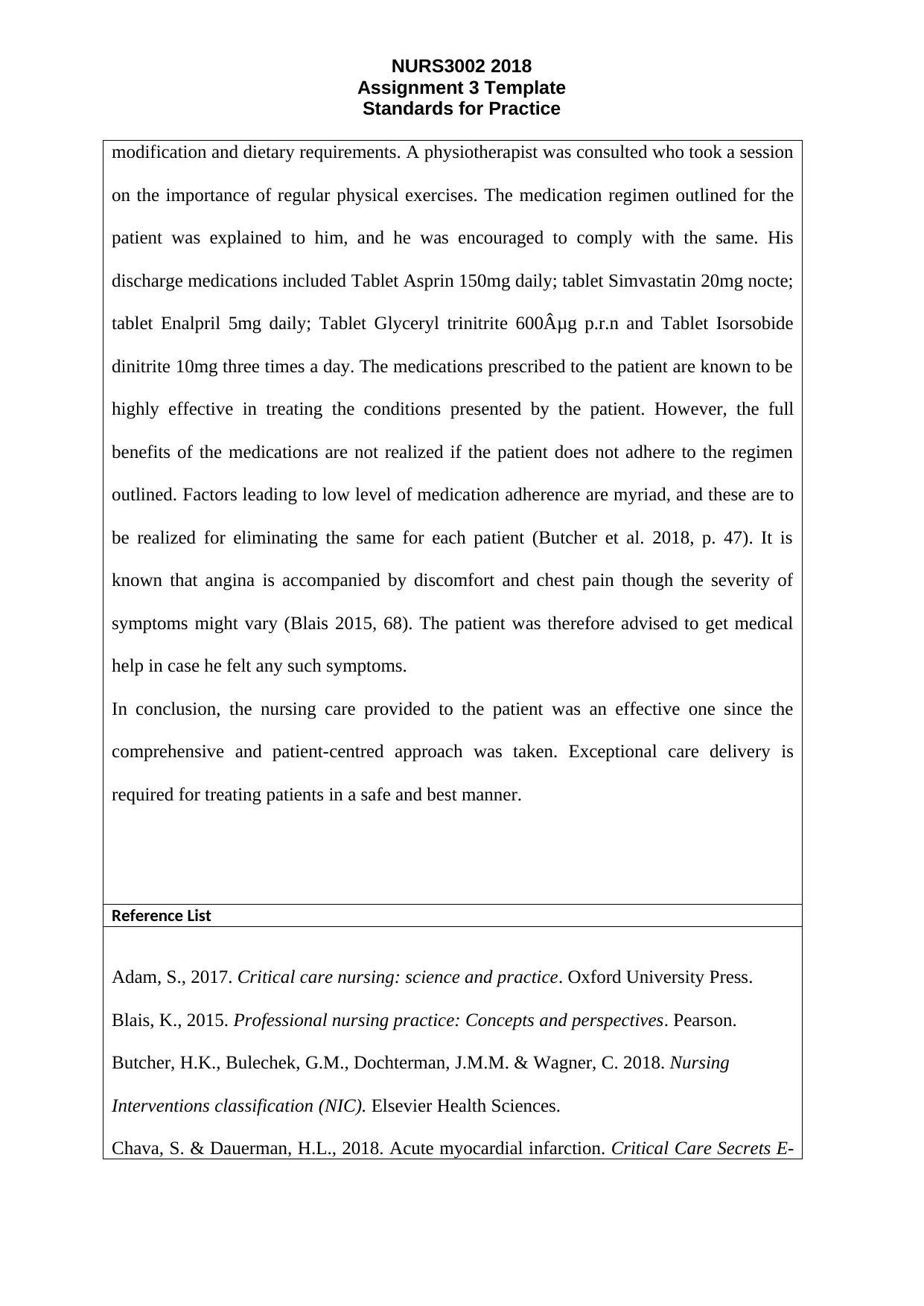
NURS3002 2018
Assignment 3 Template
Standards for Practice
modification and dietary requirements. A physiotherapist was consulted who took a session
on the importance of regular physical exercises. The medication regimen outlined for the
patient was explained to him, and he was encouraged to comply with the same. His
discharge medications included Tablet Asprin 150mg daily; tablet Simvastatin 20mg nocte;
tablet Enalpril 5mg daily; Tablet Glyceryl trinitrite 600Âμg p.r.n and Tablet Isorsobide
dinitrite 10mg three times a day. The medications prescribed to the patient are known to be
highly effective in treating the conditions presented by the patient. However, the full
benefits of the medications are not realized if the patient does not adhere to the regimen
outlined. Factors leading to low level of medication adherence are myriad, and these are to
be realized for eliminating the same for each patient (Butcher et al. 2018, p. 47). It is
known that angina is accompanied by discomfort and chest pain though the severity of
symptoms might vary (Blais 2015, 68). The patient was therefore advised to get medical
help in case he felt any such symptoms.
In conclusion, the nursing care provided to the patient was an effective one since the
comprehensive and patient-centred approach was taken. Exceptional care delivery is
required for treating patients in a safe and best manner.
Reference List
Adam, S., 2017. Critical care nursing: science and practice. Oxford University Press.
Blais, K., 2015. Professional nursing practice: Concepts and perspectives. Pearson.
Butcher, H.K., Bulechek, G.M., Dochterman, J.M.M. & Wagner, C. 2018. Nursing
Interventions classification (NIC). Elsevier Health Sciences.
Chava, S. & Dauerman, H.L., 2018. Acute myocardial infarction. Critical Care Secrets E-
Assignment 3 Template
Standards for Practice
modification and dietary requirements. A physiotherapist was consulted who took a session
on the importance of regular physical exercises. The medication regimen outlined for the
patient was explained to him, and he was encouraged to comply with the same. His
discharge medications included Tablet Asprin 150mg daily; tablet Simvastatin 20mg nocte;
tablet Enalpril 5mg daily; Tablet Glyceryl trinitrite 600Âμg p.r.n and Tablet Isorsobide
dinitrite 10mg three times a day. The medications prescribed to the patient are known to be
highly effective in treating the conditions presented by the patient. However, the full
benefits of the medications are not realized if the patient does not adhere to the regimen
outlined. Factors leading to low level of medication adherence are myriad, and these are to
be realized for eliminating the same for each patient (Butcher et al. 2018, p. 47). It is
known that angina is accompanied by discomfort and chest pain though the severity of
symptoms might vary (Blais 2015, 68). The patient was therefore advised to get medical
help in case he felt any such symptoms.
In conclusion, the nursing care provided to the patient was an effective one since the
comprehensive and patient-centred approach was taken. Exceptional care delivery is
required for treating patients in a safe and best manner.
Reference List
Adam, S., 2017. Critical care nursing: science and practice. Oxford University Press.
Blais, K., 2015. Professional nursing practice: Concepts and perspectives. Pearson.
Butcher, H.K., Bulechek, G.M., Dochterman, J.M.M. & Wagner, C. 2018. Nursing
Interventions classification (NIC). Elsevier Health Sciences.
Chava, S. & Dauerman, H.L., 2018. Acute myocardial infarction. Critical Care Secrets E-
Paraphrase This Document
Need a fresh take? Get an instant paraphrase of this document with our AI Paraphraser
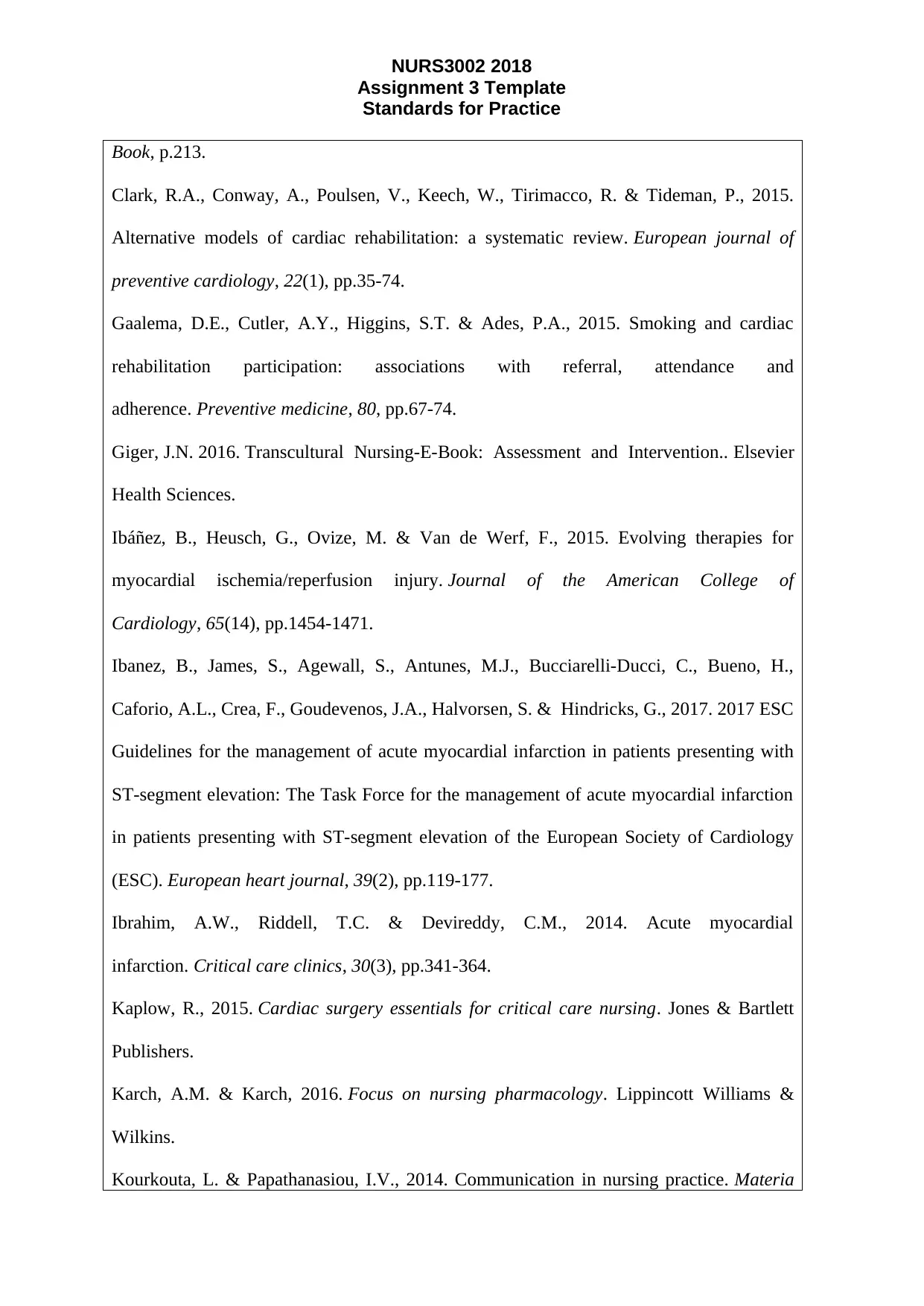
NURS3002 2018
Assignment 3 Template
Standards for Practice
Book, p.213.
Clark, R.A., Conway, A., Poulsen, V., Keech, W., Tirimacco, R. & Tideman, P., 2015.
Alternative models of cardiac rehabilitation: a systematic review. European journal of
preventive cardiology, 22(1), pp.35-74.
Gaalema, D.E., Cutler, A.Y., Higgins, S.T. & Ades, P.A., 2015. Smoking and cardiac
rehabilitation participation: associations with referral, attendance and
adherence. Preventive medicine, 80, pp.67-74.
Giger, J.N. 2016. Transcultural Nursing-E-Book: Assessment and Intervention.. Elsevier
Health Sciences.
Ibáñez, B., Heusch, G., Ovize, M. & Van de Werf, F., 2015. Evolving therapies for
myocardial ischemia/reperfusion injury. Journal of the American College of
Cardiology, 65(14), pp.1454-1471.
Ibanez, B., James, S., Agewall, S., Antunes, M.J., Bucciarelli-Ducci, C., Bueno, H.,
Caforio, A.L., Crea, F., Goudevenos, J.A., Halvorsen, S. & Hindricks, G., 2017. 2017 ESC
Guidelines for the management of acute myocardial infarction in patients presenting with
ST-segment elevation: The Task Force for the management of acute myocardial infarction
in patients presenting with ST-segment elevation of the European Society of Cardiology
(ESC). European heart journal, 39(2), pp.119-177.
Ibrahim, A.W., Riddell, T.C. & Devireddy, C.M., 2014. Acute myocardial
infarction. Critical care clinics, 30(3), pp.341-364.
Kaplow, R., 2015. Cardiac surgery essentials for critical care nursing. Jones & Bartlett
Publishers.
Karch, A.M. & Karch, 2016. Focus on nursing pharmacology. Lippincott Williams &
Wilkins.
Kourkouta, L. & Papathanasiou, I.V., 2014. Communication in nursing practice. Materia
Assignment 3 Template
Standards for Practice
Book, p.213.
Clark, R.A., Conway, A., Poulsen, V., Keech, W., Tirimacco, R. & Tideman, P., 2015.
Alternative models of cardiac rehabilitation: a systematic review. European journal of
preventive cardiology, 22(1), pp.35-74.
Gaalema, D.E., Cutler, A.Y., Higgins, S.T. & Ades, P.A., 2015. Smoking and cardiac
rehabilitation participation: associations with referral, attendance and
adherence. Preventive medicine, 80, pp.67-74.
Giger, J.N. 2016. Transcultural Nursing-E-Book: Assessment and Intervention.. Elsevier
Health Sciences.
Ibáñez, B., Heusch, G., Ovize, M. & Van de Werf, F., 2015. Evolving therapies for
myocardial ischemia/reperfusion injury. Journal of the American College of
Cardiology, 65(14), pp.1454-1471.
Ibanez, B., James, S., Agewall, S., Antunes, M.J., Bucciarelli-Ducci, C., Bueno, H.,
Caforio, A.L., Crea, F., Goudevenos, J.A., Halvorsen, S. & Hindricks, G., 2017. 2017 ESC
Guidelines for the management of acute myocardial infarction in patients presenting with
ST-segment elevation: The Task Force for the management of acute myocardial infarction
in patients presenting with ST-segment elevation of the European Society of Cardiology
(ESC). European heart journal, 39(2), pp.119-177.
Ibrahim, A.W., Riddell, T.C. & Devireddy, C.M., 2014. Acute myocardial
infarction. Critical care clinics, 30(3), pp.341-364.
Kaplow, R., 2015. Cardiac surgery essentials for critical care nursing. Jones & Bartlett
Publishers.
Karch, A.M. & Karch, 2016. Focus on nursing pharmacology. Lippincott Williams &
Wilkins.
Kourkouta, L. & Papathanasiou, I.V., 2014. Communication in nursing practice. Materia
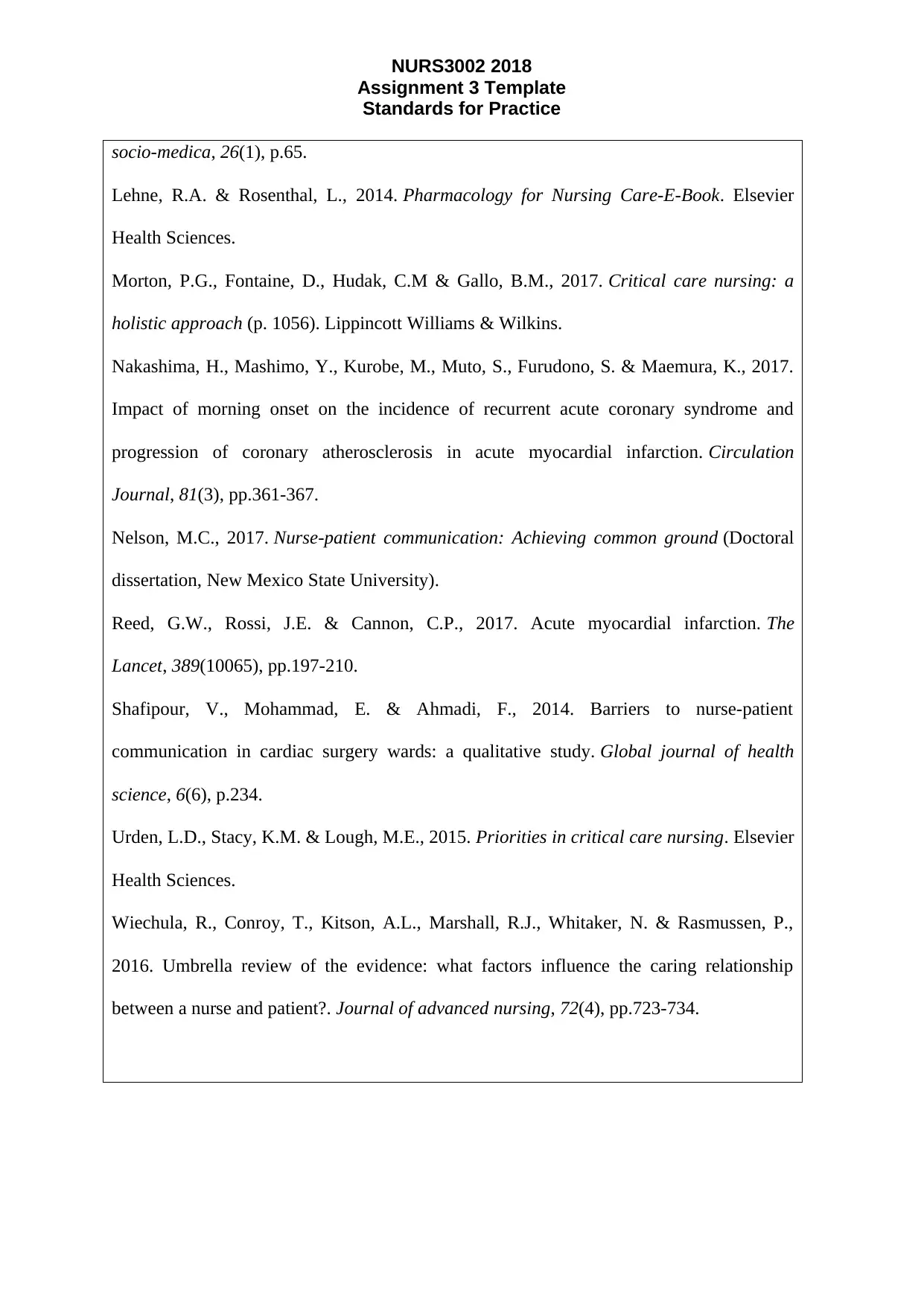
NURS3002 2018
Assignment 3 Template
Standards for Practice
socio-medica, 26(1), p.65.
Lehne, R.A. & Rosenthal, L., 2014. Pharmacology for Nursing Care-E-Book. Elsevier
Health Sciences.
Morton, P.G., Fontaine, D., Hudak, C.M & Gallo, B.M., 2017. Critical care nursing: a
holistic approach (p. 1056). Lippincott Williams & Wilkins.
Nakashima, H., Mashimo, Y., Kurobe, M., Muto, S., Furudono, S. & Maemura, K., 2017.
Impact of morning onset on the incidence of recurrent acute coronary syndrome and
progression of coronary atherosclerosis in acute myocardial infarction. Circulation
Journal, 81(3), pp.361-367.
Nelson, M.C., 2017. Nurse-patient communication: Achieving common ground (Doctoral
dissertation, New Mexico State University).
Reed, G.W., Rossi, J.E. & Cannon, C.P., 2017. Acute myocardial infarction. The
Lancet, 389(10065), pp.197-210.
Shafipour, V., Mohammad, E. & Ahmadi, F., 2014. Barriers to nurse-patient
communication in cardiac surgery wards: a qualitative study. Global journal of health
science, 6(6), p.234.
Urden, L.D., Stacy, K.M. & Lough, M.E., 2015. Priorities in critical care nursing. Elsevier
Health Sciences.
Wiechula, R., Conroy, T., Kitson, A.L., Marshall, R.J., Whitaker, N. & Rasmussen, P.,
2016. Umbrella review of the evidence: what factors influence the caring relationship
between a nurse and patient?. Journal of advanced nursing, 72(4), pp.723-734.
Assignment 3 Template
Standards for Practice
socio-medica, 26(1), p.65.
Lehne, R.A. & Rosenthal, L., 2014. Pharmacology for Nursing Care-E-Book. Elsevier
Health Sciences.
Morton, P.G., Fontaine, D., Hudak, C.M & Gallo, B.M., 2017. Critical care nursing: a
holistic approach (p. 1056). Lippincott Williams & Wilkins.
Nakashima, H., Mashimo, Y., Kurobe, M., Muto, S., Furudono, S. & Maemura, K., 2017.
Impact of morning onset on the incidence of recurrent acute coronary syndrome and
progression of coronary atherosclerosis in acute myocardial infarction. Circulation
Journal, 81(3), pp.361-367.
Nelson, M.C., 2017. Nurse-patient communication: Achieving common ground (Doctoral
dissertation, New Mexico State University).
Reed, G.W., Rossi, J.E. & Cannon, C.P., 2017. Acute myocardial infarction. The
Lancet, 389(10065), pp.197-210.
Shafipour, V., Mohammad, E. & Ahmadi, F., 2014. Barriers to nurse-patient
communication in cardiac surgery wards: a qualitative study. Global journal of health
science, 6(6), p.234.
Urden, L.D., Stacy, K.M. & Lough, M.E., 2015. Priorities in critical care nursing. Elsevier
Health Sciences.
Wiechula, R., Conroy, T., Kitson, A.L., Marshall, R.J., Whitaker, N. & Rasmussen, P.,
2016. Umbrella review of the evidence: what factors influence the caring relationship
between a nurse and patient?. Journal of advanced nursing, 72(4), pp.723-734.
⊘ This is a preview!⊘
Do you want full access?
Subscribe today to unlock all pages.

Trusted by 1+ million students worldwide
1 out of 12
Related Documents
Your All-in-One AI-Powered Toolkit for Academic Success.
+13062052269
info@desklib.com
Available 24*7 on WhatsApp / Email
![[object Object]](/_next/static/media/star-bottom.7253800d.svg)
Unlock your academic potential
Copyright © 2020–2025 A2Z Services. All Rights Reserved. Developed and managed by ZUCOL.




